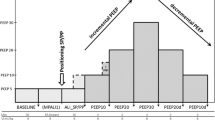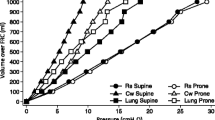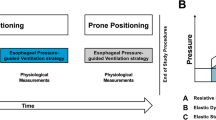Abstract
Introduction
The benefits of prone position ventilation are well demonstrated in the severe forms of acute respiratory distress syndrome, but not in the milder forms. We investigated the effects of prone position on arterial blood gases, lung inflammation, and histology in an experimental mild acute lung injury (ALI) model.
Methods
ALI was induced in Wistar rats by intraperitoneal Escherichia coli lipopolysaccharide (LPS, 5 mg/kg). After 24 h, the animals with PaO2/FIO2 between 200 and 300 mmHg were randomized into 2 groups: prone position (n = 6) and supine position (n = 6). Both groups were compared with a control group (n = 5) that was ventilated in the supine position. All of the groups were ventilated for 1 h with volume-controlled ventilation mode (tidal volume = 6 ml/kg, respiratory rate = 80 breaths/min, positive end-expiratory pressure = 5 cmH2O, inspired oxygen fraction = 1)
Results
Significantly higher lung injury scores were observed in the LPS-supine group compared to the LPS-prone and control groups (0.32 ± 0.03; 0.17 ± 0.03 and 0.13 ± 0.04, respectively) (p < 0.001), mainly due to a higher neutrophil infiltration level in the interstitial space and more proteinaceous debris that filled the airspaces. Similar differences were observed when the gravity-dependent lung regions and non-dependent lung regions were analyzed separately (p < 0.05). The BAL neutrophil content was also higher in the LPS-supine group compared to the LPS-prone and control groups (p < 0.05). There were no significant differences in the wet/dry ratio and gas exchange levels.
Conclusions
In this experimental extrapulmonary mild ALI model, prone position ventilation for 1 h, when compared with supine position ventilation, was associated with lower lung inflammation and injury.




Similar content being viewed by others
References
Pelosi P, D’Andrea L, Vitale G et al (1994) Vertical gradient of regional lung inflation in adult respiratory distress syndrome. Am J Respir Crit Care Med 149:8–13. doi:10.1164/ajrccm.149.1.8111603
Albert RK, Hubmayr RD (2000) The prone position eliminates compression of the lungs by the heart. Am J Respir Crit Care Med 161:1660–1665. doi:10.1164/ajrccm.161.5.9901037
Gattinoni L, Taccone P, Carlesso E et al (2013) Prone position in acute respiratory distress syndrome. Rationale, indications, and limits. Am J Respir Crit Care Med 188:1286–1293. doi:10.1164/rccm.201308-1532CI
Richter T, Bellani G, Harris RS et al (2005) Effect of prone position on regional shunt, aeration, and perfusion in experimental acute lung injury. Am J Respir Crit Care Med 172:480–487. doi:10.1164/rccm.200501-004OC
Galiatsou E, Kostanti E, Svarna E et al (2006) Prone position augments recruitment and prevents alveolar overinflation in acute lung injury. Am J Respir Crit Care Med 174:187–197. doi:10.1164/rccm.200506-899OC
Sinclair SE, Altemeier WA, Matute-Bello G et al (2004) Augmented lung injury due to interaction between hyperoxia and mechanical ventilation. Crit Care Med 32:2496–2501. doi:10.1097/01.CCM.0000148231.04642.8D
Broccard AF, Hotchkiss JR, Suzuki S et al (1999) Effects of mean airway pressure and tidal excursion on lung injury induced by mechanical ventilation in an isolated perfused rabbit lung model. Crit Care Med 27:1533–1541. doi:10.1097/00003246-199908000-00022
Guérin C, Reignier J, Richard JC et al (2013) Prone positioning in severe acute respiratory distress syndrome. N Engl J Med 368:2159–2168. doi:10.1056/NEJMoa1214103
Sud S, Friedrich JO, Taccone P et al (2010) Prone ventilation reduces mortality in patients with acute respiratory failure and severe hypoxemia: systemic review and meta-analysis. Intensive Care Med 36:585–599. doi:10.1007/s00134-009-1748-1
Gattinoni L, Carlesso E, Taccone P et al (2010) Prone positioning improves survival in severe ARDS: a pathophysiologic review and individual patient meta-analysis. Minerva Anestesiol 76:448–454
Vieillard-Baron A, Charron C, Caille V et al (2007) Prone positioning unloads the right ventricule in severe ARDS. Chest 132:1440–1446. doi:10.1378/chest.07-1013
Broccard AF, Shapiro RS, Schmitz LL et al (1997) Influence of prone position on the extent and distribution of lung injury in a high volume oleic acid model of acute respiratory distress syndrome. Crit Care Med 25:16–27
Broccard AF, Shapiro RS, Schmitz LL et al (2000) Prone positioning attenuates and redistributes ventilator-induced lung injury in dogs. Crit Care Med 28:295–303. doi:10.1097/00003246-200002000-00001
Matute-Bello G, Downey G, Moore BB et al (2011) An official American Thoracic Society workshop report: features and measurements of experimental acute lung injury in animals. Am J Respir Crit Care Med 44:725–738. doi:10.1165/rcmb.2009-0210ST
Peterson BT, Brooks JA, Zack AG (1982) Use of microwave oven for determination of postmortem water volume of lungs. J Appl Physiol Respir Environ Exerc Physiol 52:1661–1663
Valenza F, Guglielmi M, Maffioletti M et al (2005) Prone position delays the progression of ventilator-induced lung injury in rats: does lung strain distribution play a role? Crit Care Med 33:361–367. doi:10.1097/01.CCM.0000150660.45376.7C
Santana MC, Garcia CS, Xisto DG et al (2009) Prone position prevents regional alveolar hyperinflation and mechanical stress and strain in mild experimental acute lung injury. Respir Physiol Neurobiol 167:181–188. doi:10.1016/j.resp.2009.04.006
Edgcombe H, Carter K, Yarrow S (2008) Anaesthesia in the prone position. Br J Anaesth 100:165–183. doi:10.1093/bja/aem380
Albert RK, Hubmayr RD (2000) The prone position eliminates compression of the lungs by the heart. Am J Respir Crit Care Med 161:1660–1665. doi:10.1164/ajrccm.161.5.9901037
Mutoh T, Guest RJ, Lamm WJ et al (1992) Prone position alters the effect of volume overload on regional pleural pressures and improves hypoxemia in pigs in vivo. Am Rev Respire Dis 146:300–306. doi:10.1164/ajrccm/146.2.300
Pelosi P, D’Andrea L, Vitale G et al (1994) Vertical gradient of regional lung inflation in adult respiratory distress syndrome. Am J Respir Crit Care Med 149:8–13. doi:10.1164/ajrccm.149.1.8111603
Acknowledgments
This study was funded by a research grant from Rede Mineira TOXIFAR, Fundação de Amparo a Pesquisa do Estado de Minas Gerais (FAPEMIG), Center of Reproductive Biology, and Programa de Apoio ao Recém-Doutor/Propesq/UFJF (2013/2014).
Author information
Authors and Affiliations
Corresponding author
Ethics declarations
Conflict of Interest
The authors declare that they have no conflicts of interest.
Ethical approval
All applicable international and national guidelines for the care and use of animals were followed. All procedures performed in studies involving animals were in accordance with the ethical standards of the institution or practice at which the studies were conducted. This study was approved by the Ethics Committee in Animal Experiments of Federal University of Juiz de Fora.
Rights and permissions
About this article
Cite this article
Bianchi, A.M.A., Reboredo, M.M., Lucinda, L.M.F. et al. The Effects of Prone Position Ventilation on Experimental Mild Acute Lung Injury Induced by Intraperitoneal Lipopolysaccharide Injection in Rats. Lung 194, 193–199 (2016). https://doi.org/10.1007/s00408-016-9853-8
Received:
Accepted:
Published:
Issue Date:
DOI: https://doi.org/10.1007/s00408-016-9853-8




